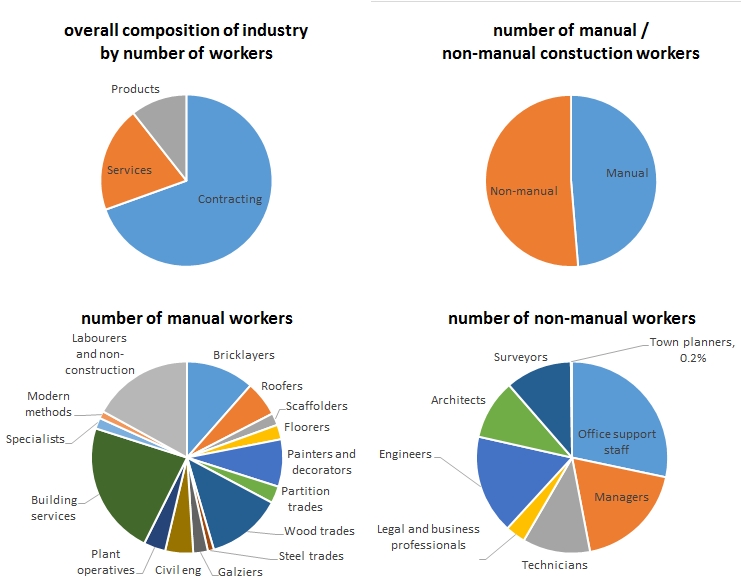Composition of UK construction industry 2013
Construction in the UK accounts for approximately 3 million jobs, 10% of total UK employment (ref Construction 2025) and includes both manufacturing and services.
In July 2013, the Department for Business, Innovation and Skills (BIS) published UK Construction, An economic analysis of the sector. This was based on Office for National Statistics (ONS) Annual Business Survey (2011 provisional results) and BIS analysis of ONS Labour Force Survey micro-data (January – March 2013 data).
The report found that the industry is made up as follows:
- Contracting: 2,030,000 jobs, 234,000 businesses, gross value added (GVA) £63 billion.
- Services: 580,000 jobs, 30,000 businesses, gross value added, £14 billion.
- Products: 310,000 jobs, 18,000 businesses. gross value added, £13 billion.
According to BIS, the definition of these categories is as follows:
Contracting include activities such as:
- Construction of buildings e.g. commercial, residential.
- Civil engineering e.g. roads, tunnels, bridges, utilities.
- Specialised construction activities e.g. electrical and plumbing installation, demolition and site preparation, plastering, painting, roofing etc.
Services include activities such as:
- Architectural and quantity surveying activities.
- Wholesale of wood, construction and materials.
- Wholesale of hardware, plumbing and heating equipment.
- Renting and leasing of construction equipment etc.
Products, include the manufacture of construction products and materials such as:
- Bricks, tiles, cement, concrete products and plaster.
- Metal structures, doors and windows of metal, carpentry and joinery etc.
- Wiring devices, electric lighting equipment etc.
The definition excludes distribution and sales of construction products.
In March 2012, NatCen Social Research published a Survey of Employment by Occupation in the Construction Industry, based on a 2011 survey managed by ConstructionSkills (CITB Construction Industry Training Board).
The report found that 48.7% of workers in the construction industry were manual workers, whilst 51.3% were non manual. These workers were broken down as follows:
Non manual:
- Office support staff, 28.3%
- Managers, 18.7%
- Technicians, 11.4%
- Legal and business professionals, 3.4%
- Engineers, 16.7%
- Architects, 10.1%
- Surveyors, 11.2%
- Town planners, 0.2%
Manual:
- Bricklayers, 11.5%
- Roofers, 5.9%
- Scaffolders, 2.0%
- Floorers, 2.5%
- Painters and decorators, 8.0%
- Partition trades, 2.9%
- Wood trades, 12.7%
- Steel trades ,1.0%
- Galziers, 2.5%
- Civil engineering, 4.7%
- Plant operatives, 3.7%
- Building services, 22.5%
- Specialists, 1.8%
- Modern methods, 1.2%
- Labourers and non-construction, 17.0%
[edit] Find out more
[edit] Related articles on Designing Buildings Wiki
- Construction 2025.
- Construction industry statistics.
- Government departments responsibility for construction.
- UK construction industry.
[edit] External references
- BIS, UK Construction, An economic analysis of the sector, July 2013.
- NatCen Social Research Survey of Employment by Occupation in the Construction Industry, March 2012.
Featured articles and news
RTPI leader to become new CIOB Chief Executive Officer
Dr Victoria Hills MRTPI, FICE to take over after Caroline Gumble’s departure.
Social and affordable housing, a long term plan for delivery
The “Delivering a Decade of Renewal for Social and Affordable Housing” strategy sets out future path.
A change to adoptive architecture
Effects of global weather warming on architectural detailing, material choice and human interaction.
The proposed publicly owned and backed subsidiary of Homes England, to facilitate new homes.
How big is the problem and what can we do to mitigate the effects?
Overheating guidance and tools for building designers
A number of cool guides to help with the heat.
The UK's Modern Industrial Strategy: A 10 year plan
Previous consultation criticism, current key elements and general support with some persisting reservations.
Building Safety Regulator reforms
New roles, new staff and a new fast track service pave the way for a single construction regulator.
Architectural Technologist CPDs and Communications
CIAT CPD… and how you can do it!
Cooling centres and cool spaces
Managing extreme heat in cities by directing the public to places for heat stress relief and water sources.
Winter gardens: A brief history and warm variations
Extending the season with glass in different forms and terms.
Restoring Great Yarmouth's Winter Gardens
Transforming one of the least sustainable constructions imaginable.
Construction Skills Mission Board launch sector drive
Newly formed government and industry collaboration set strategy for recruiting an additional 100,000 construction workers a year.
New Architects Code comes into effect in September 2025
ARB Architects Code of Conduct and Practice available with ongoing consultation regarding guidance.
Welsh Skills Body (Medr) launches ambitious plan
The new skills body brings together funding and regulation of tertiary education and research for the devolved nation.
Paul Gandy FCIOB announced as next CIOB President
Former Tilbury Douglas CEO takes helm.
UK Infrastructure: A 10 Year Strategy. In brief with reactions
With the National Infrastructure and Service Transformation Authority (NISTA).























